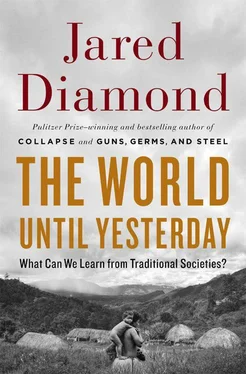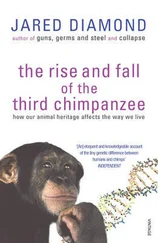Insofar as we can judge from archaeological evidence about the organization of past societies, probably all humans lived in such bands until at least a few tens of thousands of years ago, and most still did as recently as 11,000 years ago. When Europeans began, especially after Columbus’s first voyage of AD 1492, to expand around the world and to encounter non-European peoples living in non-state societies, bands still occupied all or most of Australia and the Arctic, plus low-productivity desert and forest environments of the Americas and sub-Saharan Africa. Band societies that will frequently be discussed in this book include the !Kung of Africa’s Kalahari Desert, the Ache and Siriono Indians of South America, the Andaman Islanders of the Bay of Bengal, the Pygmies of African equatorial forests, and Machiguenga Indian gardeners of Peru. All of the examples mentioned in the preceding sentence except the Machiguenga are or were hunter-gatherers.
Bands grade into the next larger and more complex type of society (termed by Service a tribe), consisting of a local group of hundreds of individuals. That’s still just within the group size limit where everyone can know everyone else personally and there are no strangers. For instance, in my high school of about 200 students all students and teachers knew each other by name, but that was impossible in my wife’s high school with thousands of students. A society of hundreds means dozens of families, often divided into kinship groups termed clans, which may exchange marriage partners with other clans. The higher populations of tribes than of bands require more food to support more people in a small area, and so tribes usually are farmers or herders or both, but a few are hunter-gatherers living in especially productive environments (such as Japan’s Ainu people and North America’s Pacific Northwest Indians). Tribes tend to be sedentary, and to live for much or all of the year in villages located near their gardens, pastures, or fisheries. However, Central Asian herders and some other tribal peoples practise transhumance—i.e., moving livestock seasonally between different altitudes in order to follow the growth of grass at higher elevations as the season advances.
In other respects tribes still resemble large bands—for instance, in their relative egalitarianism, weak economic specialization, weak political leadership, lack of bureaucrats, and face-to-face decision-making. I’ve watched meetings in New Guinea villages where hundreds of people sit on the ground, manage to have their say, and reach a conclusion. Some tribes have a “big man” who functions as a weak leader, but he leads only by his powers of persuasion and personality rather than by recognized authority. As an example of the limits of a “big man’s” powers, we shall see in Chapter 3how the ostensible followers of a leader named Gutelu of the New Guinea Dani tribe succeeded in thwarting Gutelu’s will and launching a genocidal attack that split Gutelu’s political alliance. Archaeological evidence of tribal organization, such as remains of substantial residential structures and settlements, suggests that tribes were emerging in some areas by at least 13,000 years ago. In recent times tribes have still been widespread in parts of New Guinea and Amazonia. Tribal societies that I’ll discuss in this book include Alaska’s Iñupiat, South America’s Yanomamo Indians, Afghanistan’s Kirghiz, New Britain’s Kaulong, and New Guinea’s Dani, Daribi, and Fore.
Tribes then grade into the next stage of organizational complexity, called a chiefdom and containing thousands of subjects. Such a large population, and the incipient economic specialization of chiefdoms, require high food productivity and the ability to generate and store food surpluses for feeding non-food-producing specialists, like the chiefs and their relatives and bureaucrats. Hence chiefdoms have built sedentary villages and hamlets with storage facilities and have mostly been food-producing (farming and herding) societies, except in the most productive areas available to hunter-gatherers, such as Florida’s Calusa chiefdom and coastal Southern California’s Chumash chiefdoms.
In a society of thousands of people it’s impossible for everyone to know everyone else or to hold face-to-face discussions that include everybody. As a result, chiefdoms confront two new problems that bands or tribes did not. First, strangers in a chiefdom must be able to meet each other, to recognize each other as fellow but individually unfamiliar members of the same chiefdom, and to avoid bristling at territorial trespass and getting into a fight. Hence chiefdoms develop shared ideologies and political and religious identities often derived from the supposedly divine status of the chief. Second, there is now a recognized leader, the chief, who makes decisions, possesses recognized authority, claims a monopoly on the right to use force against his society’s members if necessary, and thereby ensures that strangers within the same chiefdom don’t fight each other. The chief is assisted by non-specialized all-purpose officials (proto-bureaucrats) who collect tribute and settle disputes and carry out other administrative tasks, instead of there being separate tax collectors, judges, and restaurant inspectors as in a state. (A source of confusion here is that some traditional societies that have chiefs and are correctly described as chiefdoms in the scientific literature and in this book are nevertheless referred to as “tribes” in most popular writing: for instance, Indian “tribes” of eastern North America, which really consisted of chiefdoms.)
An economic innovation of chiefdoms is termed a redistributive economy: instead of just direct exchanges between individuals, the chief collects tribute of food and labor, much of which is redistributed to warriors, priests, and craftsmen who serve the chief. Redistribution is thus the earliest form of a system of taxation to support new institutions. Some of the food tribute is returned to the commoners, whom the chief has a moral responsibility to support in times of famine, and who work for the chief at activities like constructing monuments and irrigation systems. In addition to these political and economic innovations beyond the practices of bands and tribes, chiefdoms pioneered the social innovation of institutionalized inequality. While some tribes already have separate lineages, a chiefdom’s lineages are ranked hereditarily, with the chief and his family being at the top, commoners or slaves at the bottom, and (in the case of Polynesian Hawaii) as many as eight ranked castes in between. For members of higher-ranked lineages or castes, the tribute collected by the chief funds a better lifestyle in terms of food, housing, and special clothing and adornments.
Hence past chiefdoms can be recognized archaeologically by (sometimes) monumental construction, and by signs such as unequal distribution of grave goods in cemeteries: some bodies (those of chiefs and their relatives and bureaucrats) were buried in large tombs filled with luxury goods such as turquoise and sacrificed horses, contrasting with small unadorned graves of commoners. Based on such evidence, archaeologists infer that chiefdoms began to arise locally by around 5500 BC. In modern times, just before the recent nearly universal imposition of state government control around the world, chiefdoms were still widespread in Polynesia, much of sub-Saharan Africa, and the more productive areas of eastern and southwestern North America, Central America, and South America outside the areas controlled by the Mexican and Andean states. Chiefdoms that will be discussed in this book include the Mailu Islanders and Trobriand Islanders of the New Guinea region, and the Calusa and Chumash Indians of North America. From chiefdoms, states emerged (from about 3400 BC onwards) by conquest or amalgamation under pressure, resulting in larger populations, often ethnically diverse populations, specialized spheres and layers of bureaucrats, standing armies, much greater economic specialization, urbanization, and other changes, to produce the types of societies that blanket the modern world.
Читать дальше










